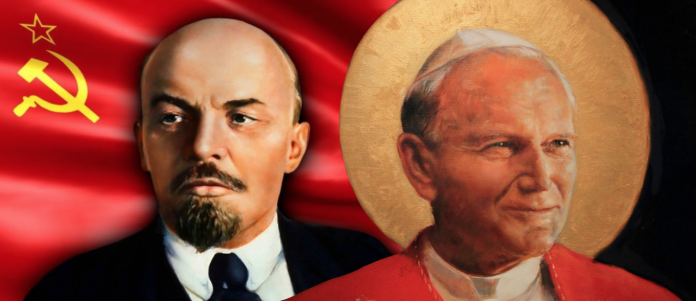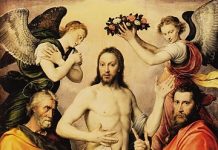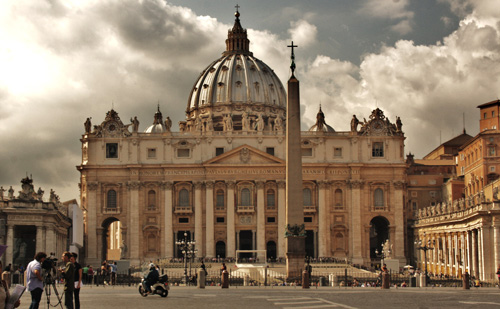(This is the second part to Paula Adamick’s historical analysis of Communism, following her first take earlier this month. Read and enjoy.
Its enduring appeal rests largely in the fact that too few have been able to grasp its nature. The majority instead succumb to its deception, skilfully concealed by the most extravagant promises.
Pius XI, Divini Redemptoris, 1937
When John le Carre was selling millions of Cold War spy novels in the 1960s and 1970s, Karol Wojtyla had been enduring the reality of Soviet Communism in Poland for decades. So had other East European nations been suffering under a reality so dark, so inexorable and so hell bent, literally, that it still required a subversive network of communist spies, infiltrators, propagandists and fellow travellers working incessantly to ensure Communism’s continuing spread around the planet.
Yet even then, years after the end of World War II in 1945 gave rise to the Cold War stalemate between the power blocks of the USSR, Red China and the United States and her allies, too few even then grasped the true nature of what had so long been underway.
Pope Pius XI had understood it, and warned the world with his inspired encyclical Divini Redemptoris, just as civil war was raging in Spain and as the USSR was attracting young Communists from leading universities across the West to penetrate and subvert the corridors of western power. Among them were ‘Stalin’s Englishmen’ aka the ‘Cambridge Five’— Kim Philby, Guy Burgess, Donald Maclean, Anthony Blunt and John Cairncross — later reputed to be the ablest group of foreign agents ever recruited by Soviet intelligence. And in the U.S., Whittaker Chambers and his treacherous nemesis, Alger Hiss. In Canada, Igor Gouzenko.
Indeed, by the time Wojtyla was elected Pope John Paul II in October 1978, the Russian-led international Communist movement had already enslaved Eastern Europe, Cuba, Mao’s China, North Korea, Cambodia and Vietnam. The domination of Latin America and Africa was underway as well, all employing the usual tactics of infiltration, agitprop (including inciting public demonstrations, rioting and violence) and attacking every human institution along the way— from media outlets and government bureaucracies to universities and even churches.
All of which meant that sixty years after the Bolsheviks had taken over Russia with promises of bread, peace and a man-made heaven on earth, Russia was still spreading her errors.
Just as Our Lady of Fatima had predicted in 1917.
A heavenly appointment
Which brings us to Karol Wojtyla— Pope John Paul II— and his role in the collapse of Soviet Communism. Having lived under oppression for much of his life, Wojtyla was just 17 when Pius XI released Divini Redemptoris and barely 19 when Hitler’s Nazis invaded Poland in September 1939, and forced him into hard labour. Refusing to bow to Nazism, he joined UNIA, a broad-based armed resistance movement trying to save Jews from the Holocaust, and later entered an underground seminary where he was influenced by Adam Sapieha, the archbishop of Krakow, who guided his thinking about human dignity and freedom.
His thinking was tested further at the end of the war when the Soviet so-called “liberation” of Poland brought additional repression and which, for the next 33 years, drove Wojtyla’s tactical opposition to the Communist government’s totalitarian rule and his steady promotion of Christianity and religious freedom. After his appointment as archbishop of Krakow in 1963, he still avoided direct criticism of the government. But clashes were inevitable as Bishop Wojtyla encountered fierce opposition to his efforts to create 11 new parishes through door-to-door evangelism, and to his insistence on publicly leading Poland’s Corpus Christi procession, a medieval feast day celebrated every June.
Then the earth shook in 1978. Bishop Wojtyla was elected pope which, in turn, armed him with an international following that, in retrospect, intimidated the Soviet empire.
“Be not afraid” became his rallying cry. And within months, Pope John Paul II released his first encyclical, Redemptor Hominis, which laid out the agenda for the rest of his papacy and set the stage for his very public confrontation with Communism, rooted in his emphasis on his personal encounter with Christ and on the dignity of the human person.
“In the face of the prospect of Communist collectivism, he made a personalist affirmation,” recalled Cardinal Georges Cottier in 2004. “The words Marxism and Communism are not found in Redemptor Hominis. But it is the foundation on the idea that one has of the human person, that the Pope placed the confrontation.”
After the encyclical was released, John Paul II led a nine-day pilgrimage through Poland in June 1979, in which one third of the population—thirteen million people—attended at least one of his events. It was also there that he warned Communist authorities that the papacy would watch them closely, and he reminded them of their responsibility “before history and before your conscience.”
His visit coincided too with the 900th anniversary of the martyrdom of St. Stanislaus which, in turn, encouraged such leading church authorities as Czech Cardinal Frantisek Tomasek to become outspoken critics of Communism. In 1980, an unemployed electrician named Lech Walesa was also inspired to form the Soviet Union’s first and only trade union—Solidarity—which duly fuelled the anti-communist movement in Poland that ultimately caused the Pope’s homeland to become one of the first dominoes to fall in the eventual collapse of Soviet Communism.
Communism vs Christianity
Through it all, John Paul II was always clear in his message that the war against Communism was fundamentally spiritual, that Communism was intrinsically evil and, as historian Paul Johnson observed, “that the ancient rulings and procedures were still in force and must be obeyed.”
Thus the flame was lit. And it would burn from one end of Poland to the other. And, as Polish General Jaruzelski admitted, “That was the detonator.”
But there was a huge price for John Paul’s spiritual boldness. A price that nearly cost his life and reminded the world of the veracity of Our Lady of Fatima’s 1917 messages. On May 13, 1981, during his regular Wednesday audience in St.Peter’s Square, Pope John Paul was shot by a Turkish assassin. His wound was severe and may have been fatal had it not been, as the Holy Father later attested, for the intervention of Our Lady herself on the very anniversary of her first appearance to the three children at Fatima.
Similar assassination attempts, all rumoured to have Soviet connections, were also made on U.S. President Ronald Reagan and U.K. Prime Minister Margaret Thatcher, both of whom had been working closely with the Pope to defang the Soviet monster. All three attempts failed, but this may be seen as evidence of just how powerful the spiritual threat of this Polish pope was to the worldly power of the Soviet empire.
Readers, of course, are familiar with the rest of the story which in 1989 saw the Berlin Wall come down and which also saw, on December 1, 1989, Soviet president Mikail Gorbachev visit John Paul in the Vatican, officially ending the hostilities between Moscow and Rome and marking the triumph of the Christian faith over Communism.
Or so it seemed.
Communism remains with us
In truth, Communism was not dead. And the war against it was far from over as John Paul faced many related battles on other fronts, all animated by the same ideology.
The edifice once known as Soviet Communism did not die, it merely reconfigured and went into hiding with its toolbox of ‘isms’–feminism, environmentalism, secularism, evolutionism, humanism, racism and so on— to be unleashed again, full strength on an exhausted world, and to further upend the natural moral order with what John Paul II had so aptly called ‘The Culture of Death’.
Meanwhile, as events were unfolding in eastern Europe, the Frankfurt School, led by Herbert Marcuse, was further assisting the cultural subversion of the West and its feverish quest to advance atheism and sink Christendom by indoctrinating ever more university students across the West. It was also Marcuse who was predicting an evolved new world that would see “the destruction of privacy, the contempt of form, the inability to tolerate silence, the proud exhibition of crudeness and brutality and an instinctual liberation that could lead to a society of sex maniacs.”
How prophetic. And how successful all these tactics turned out to be in producing new generations of godless, hedonistic, conscience-tormented, miserable individuals enslaved by appetite, hating God but “loving” the planet and licensed to indulge in all manner of sexual sin.
Liberation Theology
Still, these atheistic ideologues dedicated to spreading their doctrines remained unsatisfied. Wanting to subvert and pervert Holy Mother Church as well, they turned to Liberation Theology, a radical movement that grew up in South America as a response to the poverty and ill-treatment of ordinary citizens and caricatured by the phrase If Jesus Christ were on Earth today, he would be a Marxist revolutionary.
Their message was that the Church should act to bring about social change, and ally itself with the working class and the poor to accomplish their goals. Which, in turn, led to radical priests becoming involved in politics and trade unions while still others aligned themselves with violent revolutionary movements.
But John Paul II who’d long understood the deceits of Marxism, Communism, Socialism, Progressivism and all its ancillary bastards, saw Liberation Theology as a fusion of Christianity and Marxism and responded by closing institutions that taught the ideology and removed or rebuked the movement’s activists, such as Leonardo Boff and Gustavo Gutierrez.
Turning the Church into a secular political institution and seeing salvation solely as the achievement of social justice was to rob faith in Jesus of its power to transform every life, he said. The image of Jesus as a political revolutionary was inconsistent with the Bible and the Church’s teachings and business, which was bringing about the Kingdom of God, not about creating a Marxist utopia. “Be careful, not to accept nor allow a Vision of human life as conflict nor ideologies which propose class hatred and violence to be instilled in you; this includes those which try to hide under theological writings,” the Pope warned in a sermon in Mexico in 1990.
The unchanging Enemy
Just as John Paul II and his predecessors had always understood, the Enemy was an ever-present threat to all of humanity and had always been the unchanging. Hiding, deceptive, devious, manipulative, murderous, persistent. Whether it is Communist ideology, its agents, its promoters or its assassins.
St. John Paul II has since gone to God and to glory. Yet this unique pestilence in world history continues its lethal course.
Today, billions are ruled by governments that profess and practise the doctrine of Marx. And millions more are ruled by governments influenced by Communist policies cloaked in the Leftist language of political correctness. In a century of unprecedented and proliferating crises, there is scarcely a turmoil anywhere in which the catalyzing power of Communism— and its requisite atheism—may not be found. Atheistic Communism is and remains, as Pope Pius IX warned in 1846 and Pope Pius XI warned in 1937, a sword of division that cuts asunder families, communities, nations and empires, all the while claiming the opposite. Nor has it ever been able to deliver on a single one of its lying promises.
Since the Bolshevik seizure of power in Russia where the great Marxist experiment began, the world has suffered a century of continuous international drama. A century of civil war and genocide. A century in which countless nations, both advanced and backward, have been afflicted with the spirit of revolt in its every social, economic and political institution. A century of personal and spiritual strife that no person born in the image of God has escaped. A century of Communist ideology now charging, now retreating, but always advancing towards totalitarian tyranny. A century of internal and international intrigue and conspiracy, still being exposed and still in the style of leCarre—most recently evidenced by a Czech agent who, just last month, named British Labour leader, Jeremy Corbyn, former London mayor Ken Livingston and 13 other prominent Brits as paid Communist collaborators in the 1980s. Which they deny. Of course! As always.
Bottom line: This is an old, unchanging Enemy, deeply hostile to God and to humanity. And to which only Jesus Christ is the lone and eternal answer, the single salvation, the ultimate victor.
Today, as it was in 1846, the foundational stone and stumbling block of Christendom is still Jesus Christ Who this vicious ideology is still seeking to obliterate.
This central and eternal Truth was again confirmed last month by Hungary’s prime minister and life-long anti-communist crusader, Victor Orban, who, rejecting any semblance of political correctness in his state of the nation speech, boldly proclaimed Christianity “Europe’s last hope.”
To which I say “Amen.”












